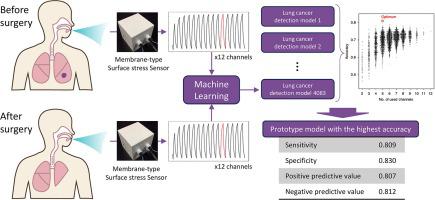当前位置:
X-MOL 学术
›
Lung Cancer
›
论文详情
Our official English website, www.x-mol.net, welcomes your feedback! (Note: you will need to create a separate account there.)
Lung cancer detection in perioperative patients' exhaled breath with nanomechanical sensor array
Lung Cancer ( IF 5.3 ) Pub Date : 2024-02-25 , DOI: 10.1016/j.lungcan.2024.107514 Yusuke Saeki , Naoki Maki , Takahiro Nemoto , Katsushige Inada , Kosuke Minami , Ryo Tamura , Gaku Imamura , Yukiko Cho-Isoda , Shinsuke Kitazawa , Hiroshi Kojima , Genki Yoshikawa , Yukio Sato
Lung Cancer ( IF 5.3 ) Pub Date : 2024-02-25 , DOI: 10.1016/j.lungcan.2024.107514 Yusuke Saeki , Naoki Maki , Takahiro Nemoto , Katsushige Inada , Kosuke Minami , Ryo Tamura , Gaku Imamura , Yukiko Cho-Isoda , Shinsuke Kitazawa , Hiroshi Kojima , Genki Yoshikawa , Yukio Sato

|
Breath analysis using a chemical sensor array combined with machine learning algorithms may be applicable for detecting and screening lung cancer. In this study, we examined whether perioperative breath analysis can predict the presence of lung cancer using a Membrane-type Surface stress Sensor (MSS) array and machine learning. Patients who underwent lung cancer surgery at an academic medical center, Japan, between November 2018 and November 2019 were included. Exhaled breaths were collected just before surgery and about one month after surgery, and analyzed using an MSS array. The array had 12 channels with various receptor materials and provided 12 waveforms from a single exhaled breath sample. Boxplots of the perioperative changes in the expiratory waveforms of each channel were generated and Mann-Whitney test were performed. An optimal lung cancer prediction model was created and validated using machine learning. Sixty-six patients were enrolled of whom 57 were included in the analysis. Through the comprehensive analysis of the entire dataset, a prototype model for predicting lung cancer was created from the combination of array five channels. The optimal accuracy, sensitivity, specificity, positive predictive value, and negative predictive value were 0.809, 0.830, 0.807, 0.806, and 0.812, respectively. Breath analysis with MSS and machine learning with careful control of both samples and measurement conditions provided a lung cancer prediction model, demonstrating its capacity for non-invasive screening of lung cancer.
中文翻译:

利用纳米机械传感器阵列检测围手术期患者呼出气中的肺癌
使用化学传感器阵列与机器学习算法相结合的呼吸分析可能适用于检测和筛查肺癌。在这项研究中,我们利用膜型表面应力传感器 (MSS) 阵列和机器学习检查围手术期呼吸分析是否可以预测肺癌的存在。包括 2018 年 11 月至 2019 年 11 月期间在日本学术医疗中心接受肺癌手术的患者。在手术前和手术后大约一个月收集呼出的气体,并使用 MSS 阵列进行分析。该阵列有 12 个通道,带有各种受体材料,并提供来自单个呼出气体样本的 12 个波形。生成每个通道呼气波形围手术期变化的箱线图并进行曼-惠特尼检验。使用机器学习创建并验证了最佳肺癌预测模型。纳入了 66 名患者,其中 57 名患者纳入分析。通过对整个数据集的综合分析,通过阵列五通道的组合创建了预测肺癌的原型模型。最佳准确度、灵敏度、特异度、阳性预测值和阴性预测值分别为 0.809、0.830、0.807、0.806 和 0.812。利用 MSS 和机器学习进行呼吸分析,并仔细控制样本和测量条件,提供了肺癌预测模型,证明了其无创筛查肺癌的能力。
更新日期:2024-02-25
中文翻译:

利用纳米机械传感器阵列检测围手术期患者呼出气中的肺癌
使用化学传感器阵列与机器学习算法相结合的呼吸分析可能适用于检测和筛查肺癌。在这项研究中,我们利用膜型表面应力传感器 (MSS) 阵列和机器学习检查围手术期呼吸分析是否可以预测肺癌的存在。包括 2018 年 11 月至 2019 年 11 月期间在日本学术医疗中心接受肺癌手术的患者。在手术前和手术后大约一个月收集呼出的气体,并使用 MSS 阵列进行分析。该阵列有 12 个通道,带有各种受体材料,并提供来自单个呼出气体样本的 12 个波形。生成每个通道呼气波形围手术期变化的箱线图并进行曼-惠特尼检验。使用机器学习创建并验证了最佳肺癌预测模型。纳入了 66 名患者,其中 57 名患者纳入分析。通过对整个数据集的综合分析,通过阵列五通道的组合创建了预测肺癌的原型模型。最佳准确度、灵敏度、特异度、阳性预测值和阴性预测值分别为 0.809、0.830、0.807、0.806 和 0.812。利用 MSS 和机器学习进行呼吸分析,并仔细控制样本和测量条件,提供了肺癌预测模型,证明了其无创筛查肺癌的能力。



























 京公网安备 11010802027423号
京公网安备 11010802027423号